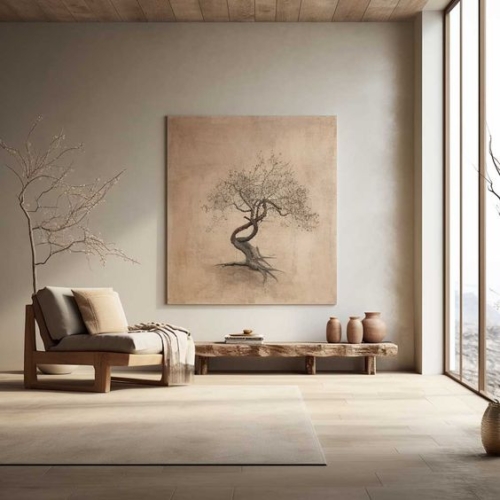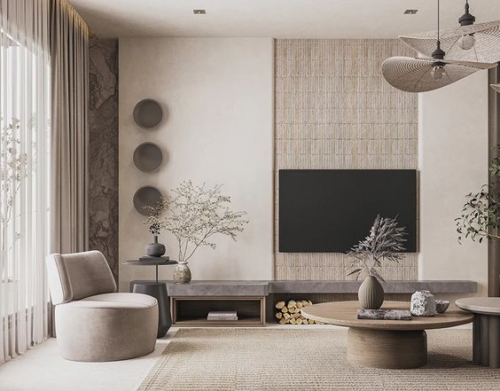In a world that often celebrates perfection and symmetry, there is a rising trend in interior design that embraces imperfection, transience, and simplicity. Wabi Sabi, a Japanese aesthetic concept, has gained traction in the world of design, offering a refreshing alternative to the glossy and meticulously curated spaces we often see. Wabi Sabi interior design is not just about aesthetics; it’s a philosophy that encourages us to find beauty in the imperfect and fleeting aspects of life.
In this article, we will delve into the world of Wabi Sabi interior design and explore how this mindful approach to beauty can transform your living spaces.
The Essence of Wabi Sabi
Before we dive into the world of interior design, it’s essential to understand the essence of Wabi Sabi itself. Wabi Sabi is a concept deeply rooted in Japanese culture and aesthetics, with its origins in Zen Buddhism. At its core, Wabi Sabi celebrates impermanence, imperfection, and the acceptance of the natural cycle of growth and decay. It encourages us to appreciate the beauty in things that are aged, weathered, and not meticulously crafted.
Core Principles of Wabi Sabi Interior Design
When it comes to interior design, Wabi Sabi is all about embracing the natural world, finding beauty in imperfection, and creating a calm environment. Here are some key elements to keep in mind when designing a Wabi Sabi style interior:
Simplicity: Embracing Minimalism
Wabi Sabi interior design embraces simplicity in all aspects. This means decluttering your space and removing unnecessary items that can distract from the essence of the room. The focus is on creating a serene and uncluttered environment that allows you to appreciate the beauty of individual elements. In a world bombarded by excess and consumerism, Wabi Sabi encourages us to take a step back and find contentment in less.
Natural Materials: Honoring Nature’s Gifts
One of the key principles of Wabi Sabi is the use of natural materials like wood, stone, and earthy textures. These materials tend to age gracefully, developing a unique patina over time. Wabi Sabi interiors often feature unpolished wooden furniture, handmade pottery, and stone accents that reflect the passage of time. The textures and colors of these materials connect us to the earth, grounding us in the natural world.
Imperfection: Celebrating Flaws
In a Wabi Sabi-inspired interior, imperfection is celebrated. This can be seen in the use of slightly uneven textures, irregular shapes, and handmade items. Embracing flaws and imperfections in your decor and furnishings adds character and depth to your living space. It reminds us that life is imperfect, and therein lies its beauty.
Patina and Weathering: The Beauty of Aging
As mentioned earlier, Wabi Sabi appreciates the beauty of things that age gracefully. This includes embracing the patina that develops on surfaces over time. Whether it’s the weathered wood of a vintage table or the rusted metal of an old lantern, these signs of wear and tear are seen as a testament to the object’s history and inherent beauty. These weathered elements tell stories, and they invite us to reflect on the passage of time.
Nature and Seasons: A Connection to the World Around Us
Wabi Sabi interior design often draws inspiration from nature and the changing seasons. Incorporating elements like dried flowers, branches, or seasonal decorations can bring the beauty of nature indoors and remind us of the transience of life. Each season brings its unique colors, textures, and moods, and by integrating them into your living space, you create a dynamic and ever-evolving environment.
Practical Tips for Wabi Sabi Interior Design
1. Choose muted, earthy colors
Opt for soft, natural tones on your walls and decor to create a calming and harmonious atmosphere.
2. Opt for handmade and artisanal items
Select furniture and decor that have a handmade or artisanal feel, showcasing craftsmanship and imperfections.
3. Maximize natural light
Use natural light as much as possible, and incorporate large windows and minimal window coverings to connect your space with the outdoors.
4. Embrace asymmetry
Allow asymmetry in your arrangements, whether it’s with furniture placement, wall decor, or the placement of objects in your space.
5. Mix old and new
Combine old and new elements to create a sense of depth and contrast in your space. Vintage pieces can harmonize beautifully with modern design, adding layers of history to your home.
Wabi Sabi interior design offers a refreshing departure from the pursuit of perfection and unattainable ideals. It reminds us to find beauty in the imperfect, the transient, and the simple aspects of life. By incorporating the principles of Wabi Sabi into your living spaces, you can create an environment that not only looks beautiful but also evokes a sense of mindfulness and appreciation for the world around you.
So, embrace the beauty of imperfection and embark on a journey to create a Wabi Sabi-inspired home that reflects the true essence of life itself. In doing so, you will not only transform your living spaces but also your perspective on the world.
Check out Inspire Your Next Kitchen Renovation with Japandi Design in Orange County for more inspirational ideas.
About Us:
Founded in 2017, Satin and Slate is one of the elite interior design studios in Southern California. Located in Long Beach, this dedicated team of designers oversees from kitchen and bathroom renovations to commercial projects. Equipped with their own showroom/studio they can satisfy the needs of any client. Featuring clean lines, bright colors and fresh ideas Satin and Slate’s mission is to bring your vision to life and help transform your space into something extraordinary.










